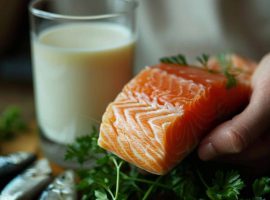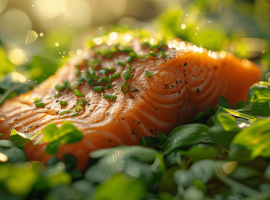High-Protein Fish Varieties and Their Nutritional Profiles
When considering fish as a source of protein, certain species stand out for their substantial protein content. Tuna, salmon, and mackerel are among the top choices, offering not only high levels of protein but also a rich array of vitamins and minerals. These nutrients are pivotal for overall health, supporting everything from bone strength to immune system function.
The Role of Omega-3 Fatty Acids in Fish
Omega-3 fatty acids, particularly EPA and DHA, are found in abundance in fatty fish like salmon and mackerel. These essential fats contribute to cardiovascular health and cognitive function, and they play a crucial role in reducing inflammation throughout the body.
Comparing Protein Quality: Fish vs. Other Sources
Fish protein is renowned for its high bioavailability and complete amino acid profile, making it a superior choice for muscle building and maintenance. When compared to plant-based proteins, which may lack certain essential amino acids, fish provides a more comprehensive nutritional package. Even within the realm of animal proteins, fish stands out for its lower saturated fat content and higher omega-3 levels, positioning it as a heart-healthy alternative to red meat.
By incorporating a variety of high-protein fish into your diet, you’re not only meeting your protein needs but also reaping the benefits of a nutrient-dense food that supports a healthy lifestyle.
Cardiovascular and Cognitive Advantages of Fish Consumption

Regular fish consumption is associated with numerous health benefits, particularly for heart and brain function. The omega-3 fatty acids found in fish, such as EPA and DHA, are essential for cardiovascular health. They aid in reducing inflammation, lowering blood pressure, and decreasing the risk of heart disease and stroke. For cognitive health, these fatty acids are vital components of brain tissue and are linked to improved memory and reduced risk of cognitive decline.
Support for Developmental Health
The benefits of fish extend to developmental stages as well. Omega-3 fatty acids are crucial for foetal development, particularly for neurological and visual systems. Pregnant individuals are often advised to include omega-3-rich fish in their diet to support the growth and development of the foetus.
Fish and Autoimmune Diseases
Fish consumption may also play a role in managing autoimmune conditions. The anti-inflammatory properties of omega-3 fatty acids can help in reducing the symptoms of autoimmune diseases. Studies suggest that regular intake of these nutrients can lead to a lower incidence of conditions like rheumatoid arthritis.
Enhancing Sleep Quality
Incorporating fish into your diet could lead to improved sleep quality. The vitamin D content in fish has been associated with better sleep patterns, possibly due to its influence on the regulation of sleep-wake cycles. Regular fish eaters often report better overall sleep quality.
Assessing Mercury and Contaminant Risks in Fish

Health Risks of Mercury in Fish
Mercury, a heavy metal found in certain fish species, poses health risks when consumed in large quantities. It can affect the nervous system, particularly in young children and foetuses, leading to cognitive and motor skill impairments. Adults are not immune; high mercury exposure can result in neurological and cardiovascular issues.
Impact of Preparation Methods on Fish Safety
The way fish is prepared can influence its safety. Cooking methods that remove fat, such as grilling or broiling, may reduce the presence of fat-soluble contaminants like PCBs. However, these methods do not affect mercury levels, as mercury binds to the proteins in fish muscle.
Strategies to Minimise Contaminant Exposure
To minimise exposure to contaminants, consumers are advised to:
– Vary their seafood choices to include species with lower mercury levels, such as salmon and sardines.
– Follow local advisories on fish consumption, especially when consuming locally caught fish.
– Remove skin and surface fat before cooking, where some pollutants may accumulate.
Comparing Contaminant Risks: Fish Oil Supplements vs. Whole Fish
Fish oil supplements often undergo processes to remove impurities, including mercury, making them a safer option for those concerned about contaminants. However, it’s essential to choose supplements certified for purity. Whole fish provide a broader range of nutrients but require careful selection to avoid high-mercury species.
Adhering to Dietary Guidelines for Fish Consumption

Frequency of Fish Intake
Dietary guidelines recommend that adults consume fish 1-2 times per week. This frequency supports a balanced intake of essential nutrients while minimising exposure to potential contaminants found in some fish species.
Recommended Protein Intake from Fish
For the average adult, the Recommended Dietary Allowance (RDA) for protein is 0.8 grammes per kilogramme of body weight. Fish, as a high-quality protein source, can contribute significantly to meeting this requirement. For example, a 3-ounce serving of salmon provides about 22 grammes of protein.
Balancing Fish with Other Protein Sources
Incorporating fish into a diet that includes a variety of protein sources is beneficial. Fish can be alternated with other lean meats, poultry, eggs, dairy, and plant-based proteins to ensure a diverse nutrient intake.
Optimal Cooking Methods to Preserve Nutrients
To preserve the nutritional integrity of fish, methods such as baking, steaming, and grilling are recommended. These methods not only maintain the quality of protein but also the levels of omega-3 fatty acids and other vital nutrients. Avoiding deep-frying and heavy sauces can also help retain the health benefits of fish.
Identifying Sustainable Seafood

When selecting seafood, it’s crucial to consider the source. Sustainable seafood is harvested in a way that preserves the long-term vitality of the species and the well-being of the oceans. To identify such options, look for certifications like the Marine Stewardship Council (MSC) and Aquaculture Stewardship Council (ASC) labels on packaging. These certifications indicate that the seafood has met rigorous standards for environmental sustainability and responsible fishing practices.
Environmental Impact: Wild vs. Farm-Raised
The choice between wild and farm-raised fish affects the environment differently. Wild-caught fish can be sustainable when sourced from populations that are abundant and fished using methods that minimise bycatch. Conversely, farm-raised fish, when produced in responsibly managed aquaculture systems, can alleviate pressure on wild stocks and provide a controlled environment that minimises habitat damage.
The Role of Certifications in Sustainability
Certifications like MSC and ASC play a pivotal role in promoting sustainability. They set the benchmark for best practices in the industry and provide a traceable system from the fishery to the consumer. This ensures that the seafood you purchase supports fisheries and farms that prioritise the health of marine ecosystems.
Benefits of Choosing Responsibly Managed Seafood
Opting for seafood from responsibly managed stocks not only supports environmental sustainability but also contributes to the livelihoods of communities that depend on fishing. By choosing certified seafood, you’re advocating for ethical practices and helping to ensure that future generations can enjoy the same diversity of seafood.
Global Dietary Traditions and the Role of Fish

Fish has long been a cornerstone in diets worldwide due to its nutritional value and availability. Across various cultures, fish is not only a source of sustenance but also a symbol of tradition and heritage.
Fish as a Cultural Staple
Globally, fish is revered for its high protein content and essential nutrients, making it a dietary mainstay. In regions where fishing is a primary industry, such as coastal and riverine communities, fish is a daily fare, deeply ingrained in the local culture.
Traditional Cuisines and Fish
Traditional cuisines often showcase fish in signature dishes, reflecting the species native to the area and the historical preparation methods passed down through generations. These dishes are a testament to the adaptability of fish as a versatile ingredient in global culinary practices.
Fish in Native American Indian Tribes
For Native American Indian Tribes, fish, particularly salmon, holds profound cultural significance. It is not only a vital food source but also a symbol of life and prosperity. Salmon are central to tribal ceremonies and are respected within their cultural narratives and practices.
Influence of Seafood Consumption Patterns
Global seafood consumption patterns are shaped by cultural preferences, economic factors, and availability. These patterns dictate the demand for certain fish types, influencing how fish is valued as a protein source. As awareness of health and sustainability grows, these patterns continue to evolve, with a noticeable shift towards species known for their health benefits and eco-friendly harvesting methods.
Optimal Cooking Methods for Protein Preservation

When preparing fish, certain cooking methods are more effective at preserving its high protein content. Techniques such as steaming, baking, and poaching are preferred as they do not involve the use of high temperatures or heavy oils that can denature proteins. Grilling and broiling are also suitable options that can enhance flavour without compromising the nutritional value of the fish.
Incorporating Fish into Healthy Dishes
Fish can be seamlessly integrated into a variety of healthy dishes. Its versatility allows it to be the centrepiece in salads, curries, tacos, and wraps. For those seeking low-carbohydrate options, fish pairs well with a medley of vegetables or can be used in protein-rich bowls and roasts.
Simple Recipes Showcasing High-Protein Fish
Simple recipes that highlight the protein-rich nature of fish include:
– Grilled salmon with a side of quinoa and steamed vegetables.
– Tuna salad served over mixed greens with a vinaigrette dressing.
– Baked cod with a light lemon and herb crust, accompanied by roasted sweet potatoes.
The Appeal of Fish’s Culinary Versatility
The culinary versatility of fish enhances its appeal as a protein source. It can be adapted to various cuisines and cooking styles, making it an excellent option for those looking to diversify their protein intake while enjoying a range of flavours and textures.
Diverse Protein Sources in Seafood

High-Protein Seafood Alternatives to Fish
Beyond fish, the ocean offers a bounty of high-protein seafood options. Shellfish such as shrimp, crab, and lobster are not only rich in protein but also low in fat, making them excellent choices for a balanced diet. Mollusks like mussels, clams, and oysters are similarly high in protein and offer additional nutrients like iron and vitamin B12.
Health Impacts of Varied Seafood Consumption
The health impacts of consuming a variety of seafood are largely positive, given the diverse nutrient profiles these foods offer. Shellfish, for example, contain beneficial compounds that can support heart health and immune function. However, it is important to be aware of potential allergens and to consume shellfish in moderation due to their cholesterol content.
Best Practices for Seafood Storage
Proper storage is key to maintaining the quality and safety of seafood. Fresh seafood should be kept in the coldest part of the refrigerator and used within two days, or it can be frozen for longer storage. Canned seafood has a longer shelf life but should be consumed by the expiration date for optimal quality.
Integrating Seafood Variety into Diets
Incorporating a variety of seafood into one’s diet can be achieved through thoughtful meal planning. Seafood can be added to salads, pasta, and soups or served as a main course. For those looking to increase their protein intake, replacing some meat-based meals with seafood is an effective strategy.
Navigating Mercury Content in Seafood

To make informed choices about fish with lower mercury content, consumers should refer to guidelines provided by health organisations. Typically, larger predatory fish like shark, swordfish, and king mackerel have higher mercury levels. Opting for smaller species such as salmon, sardines, and trout can reduce mercury intake.
Muscle-Building Benefits of Fish Protein
Fish protein is complete, containing all essential amino acids necessary for muscle building and repair. The high-quality protein found in fish is easily digestible and supports lean muscle mass development, making it a valuable component of a fitness-focused diet.
Bioavailability of Fish Protein
The bioavailability of fish protein is high, meaning the body can efficiently absorb and utilise these nutrients. This high bioavailability contributes to the overall health benefits of fish, supporting bodily functions including muscle growth, immune response, and tissue repair.
Addressing PCBs and Heavy Metal Concerns
Concerns regarding PCBs and heavy metals in fish are valid. To mitigate these risks, consumers are encouraged to:
– Choose wild-caught fish from clean waters.
– Prepare fish in ways that reduce fat content, where some contaminants accumulate.
– Stay informed about advisories for locally caught fish, which may have specific contamination risks.
Protein Profiles of Tuna, Salmon, and Mackerel

Tuna, salmon, and mackerel stand out as nutritional powerhouses in the seafood world. Each of these fish offers a unique profile of protein and essential nutrients beneficial for health.
Tuna: A Lean Protein Source
Tuna provides a high protein content with relatively low calories, making it an excellent choice for those looking to maintain or build muscle mass. A 3-ounce serving of cooked yellowfin tuna contains approximately 25 grammes of protein.
Salmon: Rich in Omega-3 and Vitamins
Salmon is renowned for its omega-3 fatty acid content, particularly EPA and DHA, which are crucial for heart and brain health. This fish is also a good source of vitamins D and B12. A similar serving of salmon offers about 22 grammes of protein.
Mackerel: Nutrient-Dense Seafood
Mackerel is another oily fish high in protein and omega-3 fatty acids. It also provides vitamins A and D, which support immune function and bone health. A 3-ounce serving of mackerel can provide around 20 grammes of protein.
Incorporating these fish into one’s diet can be done through various methods, such as grilling, baking, or adding them to salads and pastas. By doing so, individuals can enjoy the full spectrum of their nutritional benefits for optimal health outcomes.
Integrating Fish into a Diverse Diet

Incorporating fish into a diet that already includes a variety of protein sources can enhance nutritional balance and provide a multitude of health benefits. Fish, rich in omega-3 fatty acids and lean protein, complements both animal and plant proteins, offering a harmonious blend of essential nutrients.
Benefits of Lighter Fish Dishes
Lighter fish dishes not only offer a delightful culinary experience but also contribute to a healthy eating plan. They typically contain fewer calories and saturated fats, making them an ideal choice for maintaining a healthy weight. Including fish in salads, wraps, and bowls adds a flavorful protein boost without excessive calories.
Fish’s Role in Weight Management
Fish is a valuable component of weight management strategies due to its high protein content, which can increase satiety and reduce overall calorie intake. The lean protein in fish aids in preserving muscle mass during weight loss, ensuring that the body burns fat instead of muscle.
Overcoming Challenges in Diet Diversity
While integrating fish into a varied diet offers numerous benefits, it may present challenges such as dietary preferences or cooking skills. To overcome these, one can:
– Start with familiar and widely accepted fish like salmon or tuna.
– Experiment with simple cooking methods such as baking or grilling.
– Use herbs and spices to enhance flavour without adding extra calories.
By addressing these challenges, fish can become a staple in a balanced and varied diet, contributing to overall health and wellness.
Tailored Assistance from Frozen Fish Direct

Frozen Fish Direct specialises in providing a diverse selection of high-protein fish options to meet your dietary needs. Their expertise in seafood allows them to guide you in selecting the best fish for your protein requirements.
Variety and Seasonality of Offerings
Frozen Fish Direct offers an extensive range of fish, ensuring freshness and seasonality. Their selection includes, but is not limited to:
- Tuna: Known for its lean protein and versatility.
- Salmon: Rich in omega-3 fatty acids, available year-round.
- Cod: A low-fat option with a mild flavour, perfect for various recipes.
Commitment to Quality and Sustainability
Frozen Fish Direct is committed to sustainability and quality. They source their seafood from responsible fisheries and aquaculture, adhering to strict standards that ensure the long-term health of marine ecosystems.
Comprehensive Customer Support
Frozen Fish Direct provides comprehensive support to help you make informed dietary choices, including:
- Detailed nutritional profiles for all their seafood products.
- Recommendations on the best fish types for specific health goals.
- Tips on storing and preparing fish to retain its nutritional value.
By choosing Frozen Fish Direct, you are assured of quality service and premium seafood that supports both your health and the environment.








